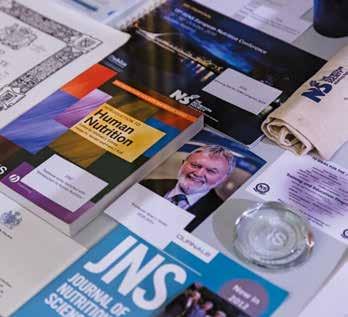
2 minute read
Archives – a space where data is sought and inspiration found
Sheila Mercieca, Archives, Library and Records Management

Shielded and cushioned beneath glass, sixty-eight items selected from the Nutrition Society’s archive collection created a narrative for seven decades of its history at the 75th celebration reception, on 5 December 2016. Continuous care of the Society’s records and corporate memory has produced an archive of information assets that evidence collaborations between nutritional scientists over 75 years. Salient archival documents of biographical and historical importance capture many political and social drivers behind the development of nutritional science. Reading the records of their lives on paper, one feels the virtue of patience, the persistence and determination, conspicuous by the competencies of each of the Society’s 26 Presidents, 1942-2017.
Mitigating risks associated with exhibiting archival documents, and maintaining a balance between preservation and access, was thoughtfully addressed at a Collections Handling workshop at Cambridge Court. The asset rich collections are a significant resource to all departments at the Society, where the mantra that preservation of archival material is the responsibility of everyone in an organisation, was sympathetically applied.

The scope of the Society’s hybrid collection contains carriers of various formats that reflect changes over time of information creation and capture; paper, photographic image, floppy disc, CD, VHS, cassette tape, and newborn digital material. Released from the silence of the archives, activities, spaces and human voices came to life to speak for themselves about the contributions made by many individuals on a journey to advance nutritional science. Moments of collaboration find expression in documents of varying significance. Signatures capturing traces of members who autographed the record of attendance at the Society’s 100th meeting (1956), are inscribed on parchment. Of no less importance is a penciled mind map on note paper for the eNutrition Academy (2014), both documents possessing the characteristics of a good record: authenticity, reliability and integrity.

Now officially registered with, and having received a unique Archon code from the National Archives, the on-going design of the Society’s archives catalogue will incorporate the whole of its collections. This catalogue will be worked on over time to reflect continual development in the Society’s collections policy, with an aim to ultimately be deliverable online. The objective in professionally managing the Society’s archives is to provide access to useable records that can be located, retrieved, presented and interpreted. A framework of policies, plans and procedures are being designed to ensure that benchmarks to achieve best practice in archives and records management will move the Society’s archives towards the National Archives accreditation.
The Nutrition Society’s commitment to the long-term preservation of its physical and digital assets is being delivered with appropriate conservation and preservation management. This preparation will lead in time to future users being able to make appointments to consult the Society’s collections. Recurring themes of interest, including malnutrition and obesity, have been discussed, debated and minuted in archival documents of nutritional science for many decades. The Society’s archives are relevant to its members, researchers, food anthropologists, nutritional science historians, social historians, educationalists, policy makers, lobbyists, undergraduate and postgraduate students. Archives are a space in which data is sought and inspiration found.




Evaluation of the 75th anniversary exhibition signposts a renewed estimation for the legal, fiscal and historical value of the Society’s archives collections. Exhibitions have the power to reinvigorate a collection and inspire new audiences. Moving forward the Society hopes to network with archives of other learned and scientific societies as part of its commitment to future outreach activities and exhibitions programming.




